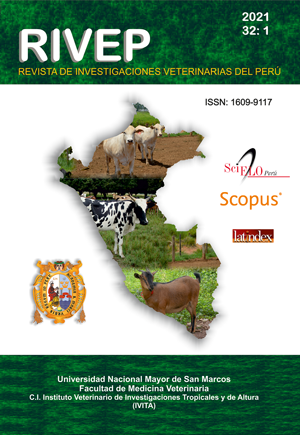Porcine Reproductive and Respiratory Syndrome: A review of the etiological agent and its influence on the current behaviour of the disease
DOI:
https://doi.org/10.15381/rivep.v32i1.19645Keywords:
PRRS, Betaarterivirus suid, immune response, biologyAbstract
Porcine reproductive and respiratory syndrome (PRRS) is a worldwide viral disease that causes reproductive failure in adult pigs and respiratory problems in young animals. PRRS causes serious economic losses, which is why it is considered the infectious disease with the greatest economic impact affecting the world swine industry. Given the proven genetic variability of the virus, the International Committee on Taxonomy of Viruses (ICTV) has reclassified the genotypes initially recognized as European and American; renaming them Betaarterivirus suid-1 and 2, respectively. The reclassification would be widely influenced by the biology of the virus, which impacts on the use of diagnostic techniques, and on the implementation of the disease control and prevention mechanisms. The objective of this review is to provide the veterinary community with updated information on the recent taxonomic classification, the organization of the genome, the mechanisms of immune response and the economic impact in South America, as well as the new alternatives for the diagnosis, control and prevention of this Viral agent of great repercussion in the national swine industry.
Downloads
Downloads
Published
Issue
Section
License
Copyright (c) 2021 Ana Castillo Espinoza, Mercy Ramírez Velásquez

This work is licensed under a Creative Commons Attribution-NonCommercial-ShareAlike 4.0 International License.
AUTHORS RETAIN THEIR RIGHTS:
a. Authors retain their trade mark rights and patent, and also on any process or procedure described in the article.
b. Authors retain their right to share, copy, distribute, perform and publicly communicate their article (eg, to place their article in an institutional repository or publish it in a book), with an acknowledgment of its initial publication in the Revista de Investigaciones Veterinarias del Perú (RIVEP).
c. Authors retain theirs right to make a subsequent publication of their work, to use the article or any part thereof (eg a compilation of his papers, lecture notes, thesis, or a book), always indicating the source of publication (the originator of the work, journal, volume, number and date).



